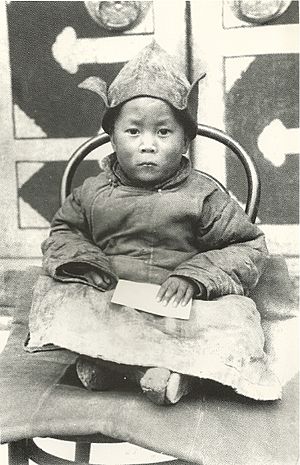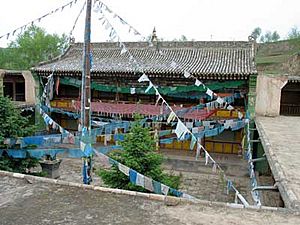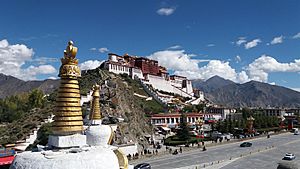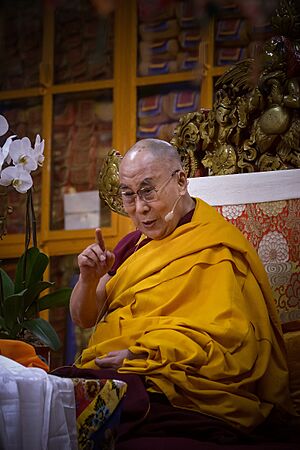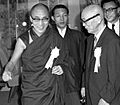14th Dalai Lama facts for kids
Quick facts for kids Tenzin Gyatso |
|||||
|---|---|---|---|---|---|
| 14th Dalai Lama | |||||
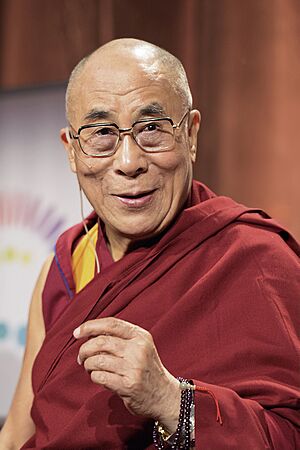
The Dalai Lama in 2012
|
|||||
| 14th Dalai Lama | |||||
| Reign | 22 February 1940 – present | ||||
| Predecessor | 13th Dalai Lama, Thubten Gyatso | ||||
| Regent |
|
||||
| Head of the Tibetan Administration for Tibetans-in-exile | |||||
| In office | 14 June 1991 – 2011 | ||||
| Head of State of Tibet | |||||
| In office | 10 March 1963 – 13 June 1991 | ||||
| Director of the Preparatory Committee for the Tibet Autonomous Region | |||||
| In office | 1956–1959 | ||||
| Predecessor | Office established | ||||
| Successor | 10th Panchen Lama, Choekyi Gyaltsen (acting) | ||||
| Vice Chairperson of the Standing Committee of the National People's Congress | |||||
| In office | 27 September 1954 – 3 January 1965 | ||||
| Born | Lhamo Thondup 6 July 1935 Taktser, Amdo |
||||
|
|||||
| Father | Choekyong Tsering | ||||
| Mother | Diki Tsering | ||||
| Religion | Tibetan Buddhism, Gelug school | ||||
| Signature |  |
||||
The 14th Dalai Lama, born Lhamo Thondup on July 6, 1935, is the current spiritual leader of Tibetan Buddhism. His full spiritual name is Jetsun Jamphel Ngawang Lobsang Yeshe Tenzin Gyatso, but he is most commonly known as Tenzin Gyatso. Before 1959, he was the spiritual and political leader of Tibet. Today, he lives in Dharamsala, India, where he leads the Central Tibetan Administration, also known as the Tibetan government-in-exile.
In Tibetan Buddhism, the Dalai Lama is believed to be a Bodhisattva, a being who chooses to be reborn to help others. Specifically, he is seen as a form of Avalokiteśvara, the Bodhisattva of Compassion. Tibetans often call him by special names like Gyalwa Rinpoche ("Precious Master") or Yizhin Norbu ("Wish-Fulfilling Gem"). Many people around the world refer to him as His Holiness the Dalai Lama.
The Dalai Lama was born to a farming family in a small village in the Tibetan region of Amdo. In 1937, he was chosen as the reincarnation of the 13th Dalai Lama. He was officially recognized as the 14th Dalai Lama in 1939 and his enthronement ceremony took place in Lhasa on February 22, 1940.
During the 1959 Tibetan uprising, the Dalai Lama fled to India. He has lived there ever since, working for the well-being of Tibetans. He created a democratic government for Tibetans in exile and has traveled the world to teach about peace, compassion, and non-violence. For his efforts, he was awarded the Nobel Peace Prize in 1989.
Contents
Early Life and Discovery
Lhamo Thondup was born on July 6, 1935, in the small village of Taktser. His family were farmers and horse traders. He was one of seven children in his family to survive childhood. Interestingly, two of his brothers were also recognized as reincarnated lamas (spiritual teachers).
After the 13th Dalai Lama passed away, monks began searching for his reincarnation. They followed signs and visions to find the next leader. One important sign was the head of the previous Dalai Lama's preserved body, which had turned to face the northeast. This suggested the new Dalai Lama would be found in that direction.
A search team, led by Kewtsang Rinpoche, traveled to the Amdo region. They had a vision of a monastery with a gold roof and a special house nearby. When they reached Taktser, they found a house that matched the vision—the home of Lhamo Thondup.
How Was He Identified?
The monks on the search team disguised themselves as pilgrims to visit the family. The leader of the group pretended to be a servant. He was holding a string of prayer beads that had belonged to the 13th Dalai Lama. The young Lhamo Thondup, who was only two years old, walked up and asked for the beads. The monk said, "If you know who I am, you can have it." The boy replied, "Sera Lama, Sera Lama," and spoke to him in the dialect of Lhasa, which his own mother could not understand.
Later, the team returned and revealed their true purpose. They tested the boy by showing him pairs of objects. One item in each pair had belonged to the 13th Dalai Lama, and the other had not. Each time, the young boy correctly chose the items that belonged to the previous Dalai Lama.
Journey to Lhasa
The local warlord, Ma Bufang, at first refused to let the boy leave. After two years of discussions and a large payment, the family was finally allowed to travel. In 1939, at the age of four, Lhamo Thondup began the long journey to Lhasa, the capital of Tibet.
When he arrived, he was officially named the 14th Dalai Lama. He was given the new name Tenzin Gyatso and began his long and difficult training as a monk and leader. He studied Buddhist philosophy, logic, and medicine. At age 23, he passed his final exams with honors, earning a degree similar to a doctorate in Buddhist philosophy.
Life as the Dalai Lama
The Dalai Lamas have been the political and religious leaders of Tibet since 1642. They ruled from the city of Lhasa. The 14th Dalai Lama's childhood was spent between the grand Potala Palace in the winter and the Norbulingka palace in the summer.
In October 1950, the army of the newly formed People's Republic of China entered Tibet. Because of this crisis, the Dalai Lama was asked to take on full political power at the age of 15, much earlier than usual.
Relationship with China
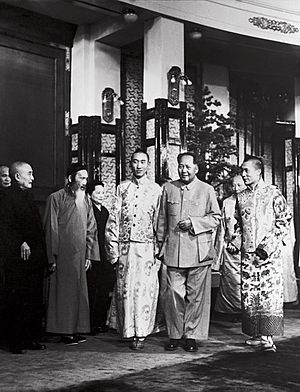
The Dalai Lama tried to work with the Chinese government. In 1951, a Tibetan delegation signed the Seventeen Point Agreement in Beijing, which recognized China's control over Tibet. The Dalai Lama later said this agreement was made under pressure.
From 1954 to 1955, the Dalai Lama toured China and met with its leader, Mao Zedong. He was impressed by the country's development. He was even selected as a Vice-chairman of the Standing Committee of the National People's Congress, a high-ranking position in the Chinese government.
However, the relationship grew tense. The Dalai Lama was shocked when Mao told him that "religion is poison." This made him realize that their views were very different.
Exile to India
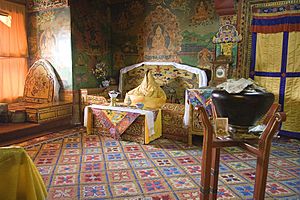
In 1959, an uprising against Chinese rule broke out in Tibet. Fearing for his life, the Dalai Lama escaped across the Himalayan mountains to India. He was 23 years old. He was welcomed by India's Prime Minister, Jawaharlal Nehru.
He established a government-in-exile in Dharamshala, a town in northern India. This area is sometimes called "Little Lhasa" because so many Tibetans live there. The Dalai Lama helped the 80,000 Tibetan refugees who followed him to build new lives. He created schools to teach Tibetan children their language, history, and culture. He also helped rebuild over 200 monasteries to preserve Tibetan Buddhism.
In 2011, the Dalai Lama retired as the political head of the Tibetan government-in-exile. He wanted the government to be led by a democratically elected leader.
International Advocate for Peace

The Dalai Lama has traveled the world to speak about peace and human rights. He no longer seeks independence for Tibet. Instead, he proposes the "Middle Way Approach." This policy asks for genuine self-rule for Tibetans within China, allowing them to protect their culture and religion while remaining part of the country.
He has met with many world leaders, including popes and presidents, to discuss global issues. He is also a strong supporter of a world without nuclear weapons.
Teaching and Interfaith Dialogue
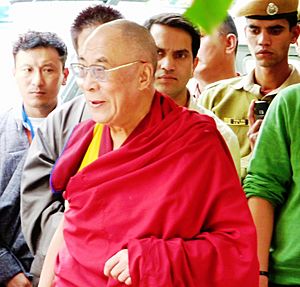
The Dalai Lama is a respected teacher. He gives talks on Buddhist philosophy, compassion, and modern ethics. His teachings are often broadcast live online for people all over the world. One of his most famous teachings is the Kalachakra, a complex ceremony for world peace that can attract hundreds of thousands of people.
He is also a strong believer in interfaith dialogue, which means bringing people of different religions together. He has met with leaders from Christianity, Judaism, Islam, Hinduism, and other faiths to promote understanding and harmony.
Interest in Science
Since he was a child, the Dalai Lama has been fascinated by science and technology. He loved taking apart and reassembling clocks, projectors, and cars. He believes that science and Buddhism can learn from each other. Both seek to understand reality through observation and analysis.
In 1987, he co-founded the Mind and Life Institute. This organization brings scientists and Buddhist scholars together to discuss topics like consciousness, the brain, and the universe. He has said that if science proves a Buddhist belief to be false, Buddhists must accept the scientific finding.
Social and Political Views
Nonviolence and Compassion
The Dalai Lama is a global symbol of non-violence. He believes that all problems should be solved through dialogue, not fighting. He often says he is a messenger of India's ancient ideas of peace and religious harmony.
He has spoken out against violence done in the name of religion. He has also called for the end of the death penalty worldwide, saying it is an act of anger, not compassion.
Environment
The Dalai Lama is very concerned about environmental issues. He often speaks about the importance of protecting our planet. He has warned that the melting glaciers in Tibet could affect billions of people in Asia who depend on rivers that start there. He encourages everyone to make ecology a part of their daily life.
Diet and Animal Welfare
The Dalai Lama promotes compassion for animals and encourages people to try a vegetarian diet. He was a vegetarian for many years. However, after health problems, his doctors advised him to eat meat occasionally. His own kitchen in Dharamshala remains completely vegetarian.
The Future of the Dalai Lama
The Dalai Lama has said that when he is around 90 years old, he will consult with other high lamas and the Tibetan people to decide if the institution of the Dalai Lama should continue.
He has stated that if he is to be reincarnated, his successor will be found outside of China, in the "free world." He has also said that the next Dalai Lama could even be a woman. He insists that the Chinese government has no right to interfere in the selection process, as it is a purely religious matter.
In July 2025, as he turned 90, the Dalai Lama confirmed that he will be reincarnated. He stated that the search for the 15th Dalai Lama must follow traditional Tibetan Buddhist practices and will be managed by his official trust.
Images for kids
-
The 14th Dalai Lama being interviewed by Voice of America journalist Lillard Hill in 1959
-
Mao Zedong and Zhou Enlai meeting with the Dalai Lama and Panchen Lama to celebrate Tibetan New Year, 1955
-
A rare photo of an adult Dalai Lama without glasses (right) and the Panchen Lama (left), 1954–1955.
-
Gyatso during a visit to Washington, D.C. in 1997
-
The Dalai Lama's main teaching room at Dharamshala
-
Remains of Dalai Lama's Dodge car. Lhasa, 1993
See also
 In Spanish: Tenzin Gyatso para niños
In Spanish: Tenzin Gyatso para niños
- Awards and honours presented to the 14th Dalai Lama
- Dalai Lama Center for Peace and Education
- History of Tibet (1950–present)
- List of peace activists
- List of Nobel laureates
- List of refugees
- List of rulers of Tibet
- Mind & Life Institute
- Templeton Prize lauretes
- Tibet Fund
- Tibet House
- Tibetan culture


